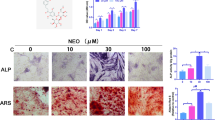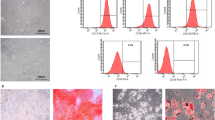Abstract
Summary
The impairment of osteoblast differentiation is one cause of the glucocorticoid-induced osteoporosis (GCOP). The quantitative proteomic analysis of the dexamethasone (DEX)-induced effects of osteoblast differentiation, proliferation, and apoptosis using stable-isotope labeling by amino acids in cell culture (SILAC) demonstrated drastic changes of some key proteins in MC3T3-E1 cells.
Introduction
The impairment of osteoblast differentiation is one of the main explanations of GCOP. SILAC enables accurate quantitative proteomic analysis of protein changes in cells to explore the underlying mechanism of GCOP.
Methods
Osteoprogenitor MC3T3-E1 cells were treated with or without 10−6 M DEX for 7 days, and the differentiation ability, proliferation, and apoptosis of the cells were measured. The protein level changes were analyzed using SILAC and liquid chromatography-coupled tandem mass spectrometry.
Results
In this study, 10−6 M DEX inhibited both osteoblast differentiation and proliferation but induced apoptosis in osteoprogenitor MC3T3-E1 cells on day 7. We found that 10−6 M DEX increased the levels of tubulins (TUBA1A, TUBB2B, and TUBB5), IQGAP1, S100 proteins (S100A11, S100A6, S100A4, and S100A10), myosin proteins (MYH9 and MYH11), and apoptosis and stress proteins, while inhibited the protein levels of ATP synthases (ATP5O, ATP5H, ATP5A1, and ATP5F1), G3BP-1, and Ras-related proteins (Rab-1A, Rab-2A, and Rab-7) in MC3T3-E1 cells.
Conclusions
Several members of the ATP synthases, myosin proteins, small GTPase superfamily, and S100 proteins may participate in functional inhibition of osteoblast progenitor cells by GCs. Such protein expression changes may be of pathological significance in coping with GCOP.





Similar content being viewed by others
Abbreviations
- ACTA:
-
Actin, alpha skeletal muscle
- ACTB:
-
Actin, cytoplasmic 1
- ALP:
-
Alkaline phosphatase
- ANXA1:
-
Annexin A1
- ANXA8:
-
Annexin A8
- ATP5A1:
-
ATP synthase subunit alpha, mitochondrial precursor
- ATP5F1:
-
ATP synthase B chain, mitochondrial precursor
- ATP5H:
-
ATP synthase D chain, mitochondrial
- ATP5O:
-
ATP synthase O subunit, mitochondrial precursor
- BAX:
-
Apoptosis regulator BAX
- DEX:
-
Dexamethasone
- G3BP1:
-
Ras GTPase-activating protein-binding protein 1
- GAPDH:
-
Glyceraldehyde-3-phosphate dehydrogenase
- GCOP:
-
GC-induced osteoporosis
- GC:
-
Glucocorticoid
- HSPA4:
-
Heat shock 70 kDa protein 4
- HSP90AA1:
-
Heat shock protein HSP 90-alpha
- IQGAP1:
-
Ras GTPase-activating-like protein 1
- INTS3:
-
Integrator complex subunit 3
- RAB:
-
Ras-related protein
- SILAC:
-
Stable-isotope labeling by amino acids in cell culture
- TUBA1A:
-
Tubulin alpha-1 chain
- TUBB2B:
-
Tubulin beta-2B chain
- TUBB5:
-
Tubulin beta-5 chain
- LC-MS/MS:
-
Liquid chromatography-coupled tandem mass spectrometry
- MTT:
-
3-(4,5-dimethylthiazol-2-yl)-2,5-diphenyltetrazolium bromide
- MYH9:
-
Myosin 9
- MYBBP1A:
-
Myb-binding protein 1A
- MYH11:
-
Isoform 1 of myosin 11
- PDCD6IP:
-
Programmed cell death 6-interacting protein
- PDCD6:
-
Programmed cell death 6
- PIGOK:
-
Protein Interrogation of Gene Ontology and KEGG databases
- PTRF:
-
Polymerase I and transcript release factor
- PPIB:
-
Peptidylprolyl isomerase B
- VCP:
-
Transitional endoplasmic reticulum ATPase
References
Canalis E, Bilezikian JP, Angeli A et al (2004) Perspectives on glucocorticoid-induced osteoporosis. Bone 34:593–598
Rubin MR, Bilezikian JP (2002) Clinical review 151: the role of parathyroid hormone in the pathogenesis of glucocorticoid-induced osteoporosis: a re-examination of the evidence. J Clin Endocrinol Metab 87:4033–4041
Bouvard B, LeGrand C, Audran M et al (2010) Glucocorticoid-induced osteoporosis: a review. Clin Rev Bone Miner Metab 8:15–26
Smith E, Frenkel B (2005) Glucocorticoids inhibit the transcriptional activity of LEF/TCF in differentiating osteoblasts in a glycogen synthase kinase-3beta-dependent and -independent manner. J Biol Chem 280:2388–2394
Ohnaka K, Tanabe M, Kawate H et al (2005) Glucocorticoid suppresses the canonical Wnt signal in cultured human osteoblasts. Biochem Biophys Res Commun 329:177–181
Leclerc N, Noh T, Cogan J et al (2008) Opposing effects of glucocorticoids and Wnt signaling on Krox20 and mineral deposition in osteoblast cultures. J Cell Biochem 103:1938–1951
Camps M, Nichols A, Arkinstall S (2000) Dual specificity phosphatases: a gene family for control of MAP kinase function. FASEB J 14:6–16
Canalis E (2008) Notch signaling in osteoblasts. Sci Signal 1:pe17
Iu MF, Kaji H, Sowa H et al (2005) Dexamethasone suppresses Smad3 pathway in osteoblastic cells. J Endocrinol 185:131–138
Ong SE, Blagoev B, Kratchmarova I et al (2002) Stable isotope labeling by amino acids in cell culture, SILAC, as a simple and accurate approach to expression proteomics. Mol Cell Proteomics 1:376–386
Jacob RJ, Cramer R (2006) PIGOK: linking protein identity to gene ontology and function. J Proteome Res 5:3429–3432
Marenholz I, Heizmann CW, Fritz G (2004) S100 proteins in mouse and man: from evolution to function and pathology (including an update of the nomenclature). Biochem Biophys Res Commun 322:1111–1122
Engelbrecht Y, de Wet H, Horsch K et al (2003) Glucocorticoids induce rapid up-regulation of mitogen-activated protein kinase phosphatase-1 and dephosphorylation of extracellular signal-regulated kinase and impair proliferation in human and mouse osteoblast cell lines. Endocrinology 144:412–422
Lian JB, Shalhoub V, Aslam F et al (1997) Species-specific glucocorticoid and 1, 25-dihydroxyvitamin D responsiveness in mouse MC3T3–E1 osteoblasts: dexamethasone inhibits osteoblast differentiation and vitamin D down-regulates osteocalcin gene expression. Endocrinology 138:2117–2127
Smith E, Redman RA, Logg CR et al (2000) Glucocorticoids inhibit developmental stage-specific osteoblast cell cycle. Dissociation of cyclin A-cyclin-dependent kinase 2 from E2F4-p130 complexes. J Biol Chem 275:19992–20001
O’Brien CA, Jia D, Plotkin LI et al (2004) Glucocorticoids act directly on osteoblasts and osteocytes to induce their apoptosis and reduce bone formation and strength. Endocrinology 145:1835–1841
Jaglin XH, Poirier K, Saillour Y et al (2009) Mutations in the beta-tubulin gene TUBB2B result in asymmetrical polymicrogyria. Nat Genet 41:746–752
Keays DA, Tian G, Poirier K et al (2007) Mutations in alpha-tubulin cause abnormal neuronal migration in mice and lissencephaly in humans. Cell 128:45–57
Plauchu H, Encha-Razavi F, Hermier M et al (2001) Lissencephaly type III, stippled epiphyses and loose, thick skin: a new recessively inherited syndrome. Am J Med Genet 99:14–20
Shi X, Yang X, Chen D et al (1999) Smad1 interacts with homeobox DNA-binding proteins in bone morphogenetic protein signaling. J Biol Chem 274:13711–13717
Yang X, Ji X, Shi X et al (2000) Smad1 domains interacting with Hoxc-8 induce osteoblast differentiation. J Biol Chem 275:1065–1072
Oster G, Wang H (2000) Reverse engineering a protein: the mechanochemistry of ATP synthase. Biochim Biophys Acta 1458:482–510
Tsai B, Ye Y, Rapoport TA (2002) Retro-translocation of proteins from the endoplasmic reticulum into the cytosol. Nat Rev Mol Cell Biol 3:246–255
Ye Y, Shibata Y, Yun C et al (2004) A membrane protein complex mediates retro-translocation from the ER lumen into the cytosol. Nature 429:841–847
Sakaguchi M, Sonegawa H, Murata H et al (2008) S100A11, an dual mediator for growth regulation of human keratinocytes. Mol Biol Cell 19:78–85
Fullen DR, Reed JA, Finnerty B et al (2001) S100A6 expression in fibrohistiocytic lesions. J Cutan Pathol 28:229–234
Ilg EC, Schafer BW, Heizmann CW (1996) Expression pattern of S100 calcium-binding proteins in human tumors. Int J Cancer 68:325–332
Holt GE, Schwartz HS, Caldwell RL (2006) Proteomic profiling in musculoskeletal oncology by MALDI mass spectrometry. Clin Orthop Relat Res 450:105–110
Luo X, Sharff KA, Chen J et al (2008) S100A6 expression and function in human osteosarcoma. Clin Orthop Relat Res 466:2060–2070
Marenholz I, Lovering RC, Heizmann CW (2006) An update of the S100 nomenclature. Biochim Biophys Acta 1763:1282–1283
Rescher U, Gerke V (2008) S100A10/p11: family, friends and functions. Pflugers Arch 455:575–582
Yao XL, Cowan MJ, Gladwin MT et al (1999) Dexamethasone alters arachidonate release from human epithelial cells by induction of p11 protein synthesis and inhibition of phospholipase A2 activity. J Biol Chem 274:17202–17208
Siddappa R, Licht R, van Blitterswijk C et al (2007) Donor variation and loss of multipotency during in vitro expansion of human mesenchymal stem cells for bone tissue engineering. J Orthop Res 25:1029–1041
Kemppainen RJ, Behrend EN (1998) Dexamethasone rapidly induces a novel ras superfamily member-related gene in AtT-20 cells. J Biol Chem 273:3129–3131
Chen YX, Li ZB, Diao F et al (2006) Up-regulation of RhoB by glucocorticoids and its effects on the cell proliferation and NF-kappaB transcriptional activity. J Steroid Biochem Mol Biol 101:179–187
Briggs MW, Sacks DB (2003) IQGAP1 as signal integrator: Ca2+, calmodulin, Cdc42 and the cytoskeleton. FEBS Lett 542:7–11
Mateer SC, Wang N, Bloom GS (2003) IQGAPs: integrators of the cytoskeleton, cell adhesion machinery, and signaling networks. Cell Motil Cytoskeleton 55:147–155
Parker F, Maurier F, Delumeau I et al (1996) A Ras-GTPase-activating protein SH3-domain-binding protein. Mol Cell Biol 16:2561–2569
Tocque B, Delumeau I, Parker F et al (1997) Ras-GTPase activating protein (GAP): a putative effector for Ras. Cell Signal 9:153–158
Gallouzi IE, Parker F, Chebli K et al (1998) A novel phosphorylation-dependent RNase activity of GAP-SH3 binding protein: a potential link between signal transduction and RNA stability. Mol Cell Biol 18:3956–3965
Soncini C, Berdo I, Draetta G (2001) Ras-GAP SH3 domain binding protein (G3BP) is a modulator of USP10, a novel human ubiquitin specific protease. Oncogene 20:3869–3879
Zerial M, McBride H (2001) Rab proteins as membrane organizers. Nat Rev Mol Cell Biol 2:107–117
Nuoffer C, Davidson HW, Matteson J et al (1994) A GDP-bound of rab1 inhibits protein export from the endoplasmic reticulum and transport between Golgi compartments. J Cell Biol 125:225–237
Tisdale EJ, Bourne JR, Khosravi-Far R et al (1992) GTP-binding mutants of rab1 and rab2 are potent inhibitors of vesicular transport from the endoplasmic reticulum to the Golgi complex. J Cell Biol 119:749–761
Bucci C, Thomsen P, Nicoziani P et al (2000) Rab7: a key to lysosome biogenesis. Mol Biol Cell 11:467–480
Mukhopadhyay A, Funato K, Stahl PD (1997) Rab7 regulates transport from early to late endocytic compartments in Xenopus oocytes. J Biol Chem 272:13055–13059
Press B, Feng Y, Hoflack B et al (1998) Mutant Rab7 causes the accumulation of cathepsin D and cation-independent mannose 6-phosphate receptor in an early endocytic compartment. J Cell Biol 140:1075–1089
Vonderheit A, Helenius A (2005) Rab7 associates with early endosomes to mediate sorting and transport of Semliki forest virus to late endosomes. PLoS Biol 3:e233
McMichael BK, Wysolmerski RB, Lee BS (2009) Regulated proteolysis of nonmuscle myosin IIA stimulates osteoclast fusion. J Biol Chem 284:12266–12275
Soulez M, Rouviere CG, Chafey P et al (1996) Growth and differentiation of C2 myogenic cells are dependent on serum response factor. Mol Cell Biol 16:6065–6074
Tamama K, Sen CK, Wells A (2008) Differentiation of bone marrow mesenchymal stem cells into the smooth muscle lineage by blocking ERK/MAPK signaling pathway. Stem Cells Dev 17:897–908
Autret A, Martin SJ (2009) Emerging role for members of the Bcl-2 family in mitochondrial morphogenesis. Mol Cell 36:355–363
Missotten M, Nichols A, Rieger K et al (1999) Alix, a novel mouse protein undergoing calcium-dependent interaction with the apoptosis-linked-gene 2 (ALG-2) protein. Cell Death Differ 6:124–129
Chatellard-Causse C, Blot B, Cristina N et al (2002) Alix (ALG-2-interacting protein X), a protein involved in apoptosis, binds to endophilins and induces cytoplasmic vacuolization. J Biol Chem 277:29108–29115
Acknowledgements
This work is supported by the NIH (Grant DE 018385), the National Natural Science Foundation of China (30950019), and the Medicine and Health Research Fund of Zhejiang Province, China (2009B166). We thank Chantal M. Sottas for the technical support.
Conflicts of interest
None.
Author information
Authors and Affiliations
Corresponding authors
Additional information
Dun Hong and Hai-Xiao Chen contributed equally to this work.
Rights and permissions
About this article
Cite this article
Hong, D., Chen, HX., Yu, HQ. et al. Quantitative proteomic analysis of dexamethasone-induced effects on osteoblast differentiation, proliferation, and apoptosis in MC3T3-E1 cells using SILAC. Osteoporos Int 22, 2175–2186 (2011). https://doi.org/10.1007/s00198-010-1434-8
Received:
Accepted:
Published:
Issue Date:
DOI: https://doi.org/10.1007/s00198-010-1434-8




